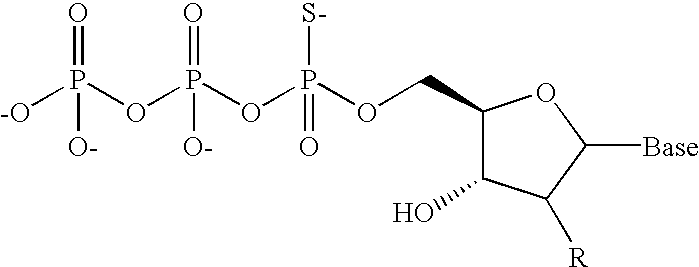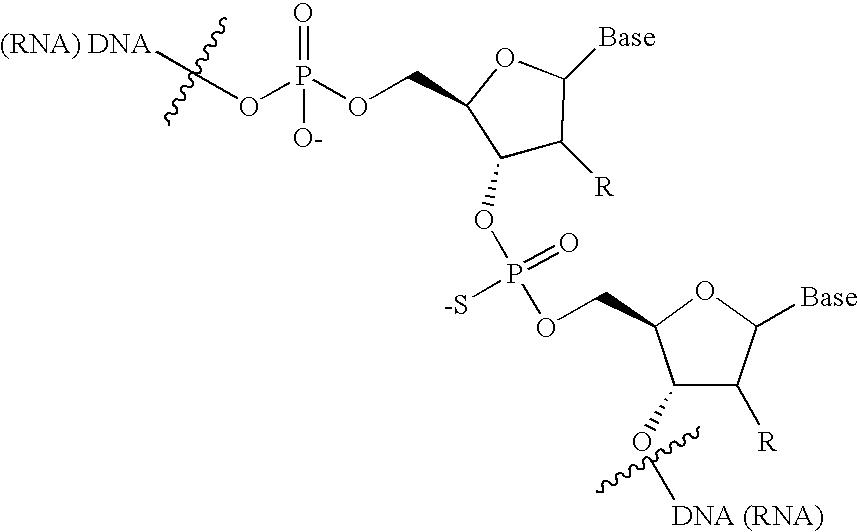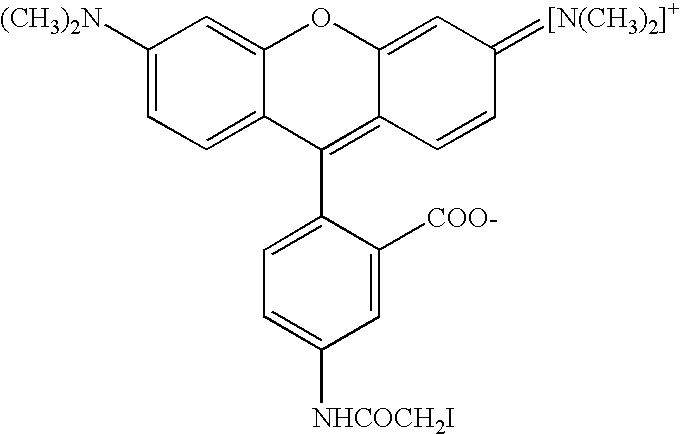Post-synthesis labeling of nucleic acids, assays using nucleic acids that are labeled post-synthetically, single nucleotide polymorphism detection, and associated compounds and microarrays
a nucleic acid and labeling technology, applied in the field of post-synthesis labeling of nucleic acids, assays using, can solve the problem of poor incorporation and reduce the signal intensity of such assays
- Summary
- Abstract
- Description
- Claims
- Application Information
AI Technical Summary
Benefits of technology
Problems solved by technology
Method used
Image
Examples
example 1
Synthesis of cRNA
[0064] A linearized plasmid DNA was used as a template for the in vitro transcription (IVT) reaction, which has a SP6 RNA polymerase promoter. Cy3-labeled cRNA was synthesized by incubating 1 .mu.g of DNA in the presence of ATP (5 mM), GTP (5 mM), CTP (3.75 mM), UTP (3.75 mM), Cy3-UTP (0.5 mM) and Cy3-CTP (0.5 mM), in 10.times.reaction buffer (Gibco) and SP6 RNA polymerase (kit from Ambion). The mixture was incubated at 37.degree. C. for 6 hours, then purified using RNeasy columns (from Qiagen). Phosphorothioate-cRNA was synthesized by substituting Cy3-labeled nucleoside triphosphates with either one or all four .alpha.-thio nucleoside triphosphates (obtained from Amersham Biosciences, also available from PerkinElmer) at a concentration of 1.5 mM. Natural cRNA was prepared using only natural nucleotides at 5 mM each. The synthesized RNA was fragmented using established protocols (i.e., treated with 30 mM Mg.sup.2+ at 94.degree. C. for 15 minutes).
##ic example 2
Prophetic Example 2
Labeling with Reactive Dyes
[0065] Three different compounds were tested as labeling dyes: TMR-maleimide (formula shown previously), TMR-iodoacetamide (formula shown previously), and Alexafluor-maleimide (obtained from Molecular Probes). A sample of cRNA (40 .mu.g in 30 .mu.L of 10 mM Tris.Cl, at pH 8.0) was treated with reactive dyes solutions (10 mM in DMF) to a final concentration of 1 mM. The mixture was kept at 50.degree. C. for 24 hours, and the unreacted dye removed using microspin G-6 columns (Amersham). The cRNA product was used directly in hybridization experiments on microarrays following the procedures in "3D-Link.TM. Protocol Information," Motorola Life Sciences, Northbrook, Ill., USA (2001).
example 3
Gel Analysis
[0066] Ten samples, as described in Table 1 below, were run on a 1% agarose gel.
1TABLE 1 SAMPLES 1-10 RUN ON GEL LANE SAMPLE 1 1 kb DNA ladder (from Promega) 2 Cy3-cRNA 3 Phosphorothio-cRNA-NO DYE 4 Phosphorothio-cRNA-NO DYE 5 Phosphorothio-cRNA-NO DYE 6 Natural cRNA-TMR-iodoacetamide 7 Phosphorothio-cRNA-TMR-iodoacetamide 8 Phosphorothio-cRNA-TMR-ma-leimide 9 Phosphorothio-cRNA-Alexafluor Dye 10 Natural cRNA-TMR-maleimide
[0067] Initially, the gel was not stained, and an image taken using a Fluorimager using Cy3-settings. The gel was then stained with ethidium bromide (EtBr), and analyzed using EtBr-settings. The gel images showed that natural cRNA that does not contain any phosphorothioates does not get labeled with maleimide. In samples 3-5, the phosphorothioate-cRNA was not labeled, whereas in samples 7-9, the phosphorothioate-cRNA was labeled. The gel images showed that phosphorothioate-cRNA is labeled only after treatment with the alkylating dyes.
[0068] Further, the...
PUM
| Property | Measurement | Unit |
|---|---|---|
| temperature | aaaaa | aaaaa |
| pH | aaaaa | aaaaa |
| electrophilic | aaaaa | aaaaa |
Abstract
Description
Claims
Application Information
 Login to View More
Login to View More - R&D
- Intellectual Property
- Life Sciences
- Materials
- Tech Scout
- Unparalleled Data Quality
- Higher Quality Content
- 60% Fewer Hallucinations
Browse by: Latest US Patents, China's latest patents, Technical Efficacy Thesaurus, Application Domain, Technology Topic, Popular Technical Reports.
© 2025 PatSnap. All rights reserved.Legal|Privacy policy|Modern Slavery Act Transparency Statement|Sitemap|About US| Contact US: help@patsnap.com



